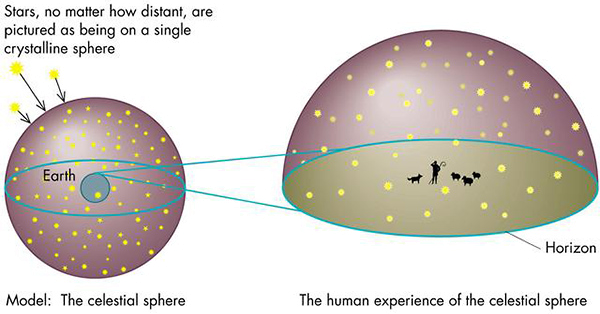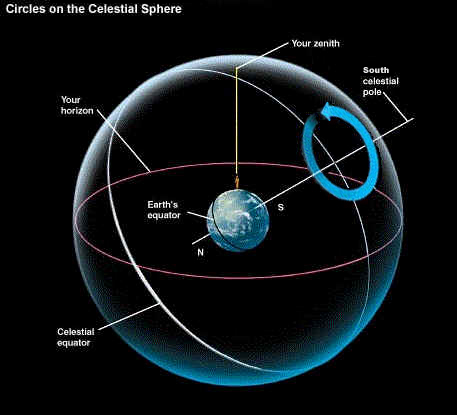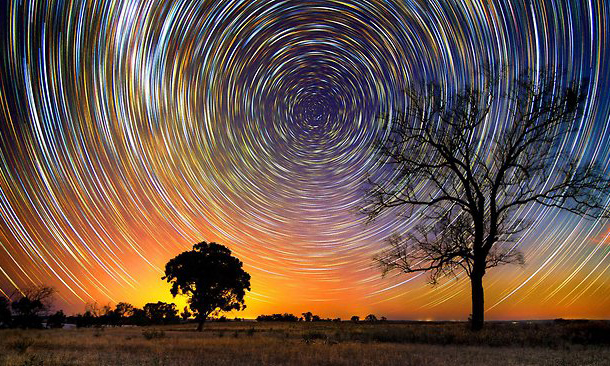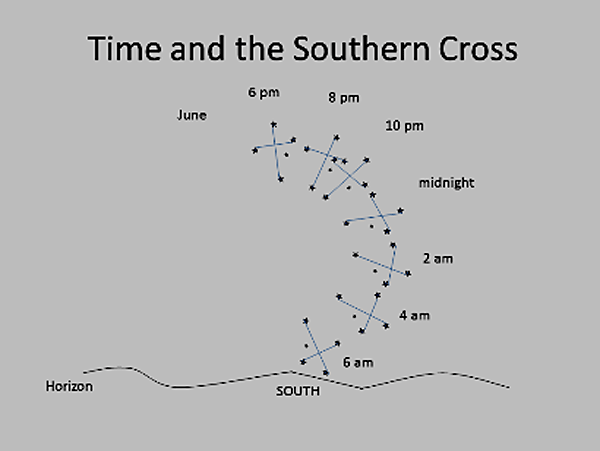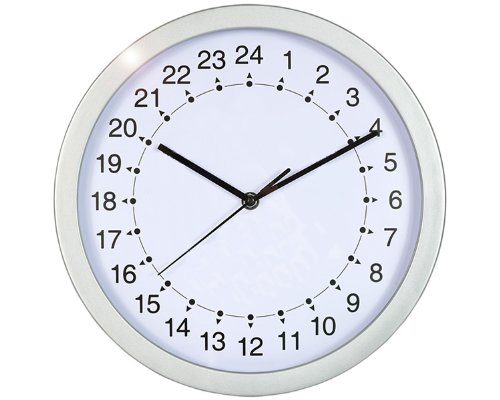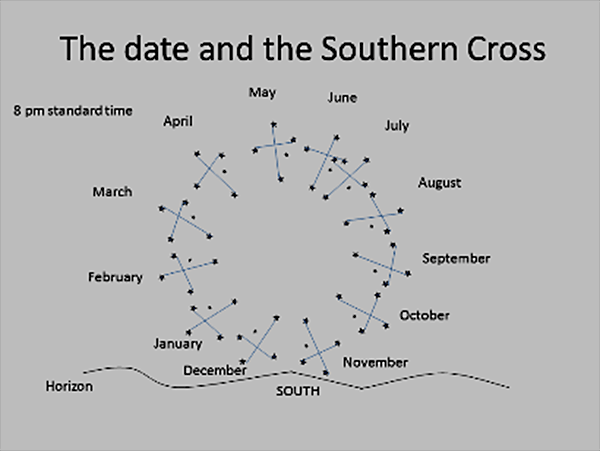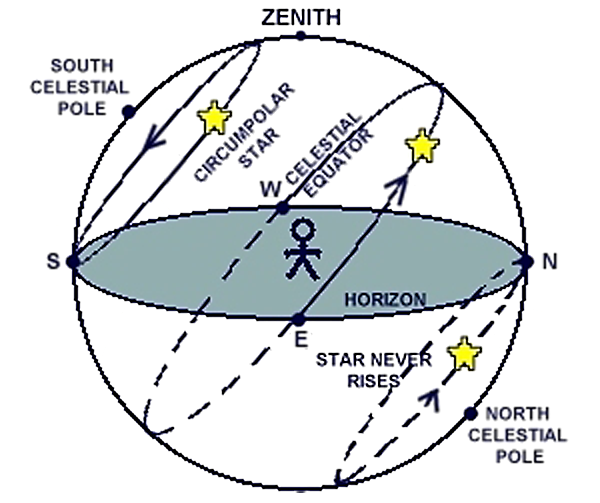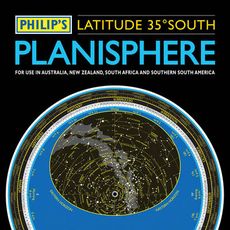
|
|||||||||||
How to Read the Sky at NightPractical Astronomy for Date, Time, and Direction FindingThis new page describes some practical astronomy that you can learn quickly — for finding direction, and other things that people could read from the sky in ancient times, before modern technology. The information on this page at first will relate only to the southern hemisphere, later I might add some northern hemisphere information. There are already a lot of websites about the north hemisphere. On This PageThe Basics Why Learn Observational Astronomy?With regards to the subject matter of survival.ark.au, there are at least three reasons:
The BasicsMost people already know that the Sun rises in approximately the east, and sets in (approximately) the west. A good first practical exercise for this is to start to take some notice of where the Sun is throughout the day. Where in the sky is the Sun right now? If it's night-time right now you might say that the Sun isn't in the sky at all. But it's still somewhere. See if you can point your arm towards where the Sun would be right now, daytime or night-time. The second thing to know is that everything else "natural" in space, that you can see in the sky (excluding man made objects like satellites and/or any visiting aliens) also moves pretty much in the same fashion as the Sun. That is the Moon, the planets, and most of the stars all approximately rise in the east and set in the west. The Celestial SphereA more accurate way to describe how these sky objects move is to imagine the Earth (and you on the Earth) at the centre of a huge invisible sphere, which makes up the sky. This sphere rotates on the same axis as the Earth does, that is from the North Pole of the Earth to the South Pole. Imagine that all the stars are stuck to this sphere, and rotate with it around the sky.
Apart from tiny movements that you need large telescopes to measure, the positions of all the stars as we see them relative to each other, are fixed on this sphere. You can imagine they are glued on, or painted on like in the plastic celestial sphere model shown below. Only the very distant objects, like the stars, are fixed onto the sphere. This includes all the stars (apart from the Sun), plus other objects from astronomy including galaxies, star clusters, nebulae, and the "milky way". Closer objects (within our own solar system) including the Sun, Moon, planets and comets will move relative to this sphere of fixed stars.
The height of the celestial pole above the horizon (assuming a flat horizon with no hills or buildings etc in the way) will be equal to your latitude. For Sydney this is about 35 degrees. Therefore in Sydney the celestial pole will be about 35 degrees above the horizon — or a bit over 1/3 of the distance from the ground up to the highest point in the sky (i.e. straight up, which is called the zenith, and is 90 degrees above the horizon). The stars close to the pole will be seen to move clockwise (anticlockwise in the northern hemisphere) in a circle around the pole, and they will be visible all year around, and at any time of the night (as long as there are no clouds in the way). By "close to the pole", specifically this means closer to the pole than your latitude, measured in degrees. Taking a long exposure time photo of the stars shows how the sky appears to rotate around the celestial pole in the middle.
From a latitude close to the equator, the celestial pole appears close to the ground as in the photo below from Mount Kilimanjaro.
Finding the Time and the Date by the StarsThe diagram below (from Sydney Observatory) shows how the southern cross moves around the celestial pole (in the centre of the circle) in one night. This is assuming that it starts at the top position about about 6pm, which will only happen around June. The diagram is slightly wrong because in 12 hours (such as from 6pm to 6am), the cross should move almost exactly 180 degrees. It's actually very close to 180.5 degrees in 12 hours. This is because in one full day, the clock rotates almost exactly 361 degrees, i.e. one degree more than a full circle. Every day the starting position of the clock moves forward by one degree so that in a full year of 365 days, its gone around all the way around and back to where it was a year before.
This diagram (above) can be used to find the approximate time, providing you know what position the cross started from at the start of the night (e.g. at 6pm). The cross moves around this big circle like the hour hand of a massive 24-hour analogue clock which takes up about 1/3 of the entire visible sky. Note that the hour hand on a 24-hour clock moves half as fast as on an ordinary 12-hour clock, so that it takes a full 24 hours to go all the way around. Reading time from the Southern Cross is like having the clock below stamped onto the sky, but only the hour hand — and with the clock body itself rotated to a position that depends on the date, so that at different dates there will be different starting times at the top of the dial. The diagram under the clock shows how the starting position of the cross (at 8:00 pm) changes over different months. The rotation of this clock body against the sky (and therefore starting position of the cross) happens very slowly, by about 4 minutes on the clock dial per day (which is 1/15th of an hour, or one degree — not very much) , so that it turns a full circle exactly once per year.
Finding the DateThe next diagram shows how the position of the Southern Cross varies on different dates. The Cross will be in these positions at approximately 8:00pm (this would be 9:00 pm daylight savings time in summer) in the months as labelled below. In any given night it will rotate clockwise, starting from this position at 8:00pm. As an exercise, see if you can find the Southern Cross in the sky tonight (or soon), and compare its position to the diagrams here. Note that these times are independant of what timezone you're in. This is because it's the relative position of the Sun compared to the background stars (on the celesital sphere) that matters, and this is the same anywhere on Earth at any given time of year. You can use this diagram to find the approximate date, if you view the position of the Southern Cross when you know its about 8:00 pm — i.e. about 2 hours after sunset in midwinter, or shortly after sunset in midsummer (this is 9pm in daylight savings areas). If you had no access to modern technology whatsoever, this method would still work just as well as it does now to tell you, approximately, what month of the year it is. If its another time than 8pm, you can calculate where the cross would be at 8pm by thinking of how much it would rotate either back or forwards based on how many hours away it is from 8pm. This all sounds complicated but once you get used to looking at the position of the cross often, it becomes second nature. It's easier than learning to tell the time (hours, minutes, and seconds) on an analogue clock.
Stars close to the north celestial pole will move in a circle around the north celestial pole, and will never be seen from the southern hemisphere. These are seen in the lower right corner of the picture below (labelled with "Star never rises"). Stars within the leftmost circle are always visible (like the Southern Cross from many southern latitudes) and are called "circumpolar". Stars in between these two circles (not really close to either pole) will rise and set at different times, depending on the time and date. The middle line is called the celestial equator and is the Earth's actual equator projected onto the sky. Stars right on the celestial equator will rise in exactly the east (provided you have a flat horizon) and set in exactly the west.
Finding Direction from the StarsIn the Southern Hemisphere, the easiest direction to learn to find from the night sky is south. Finding SouthThe easiest way to find south is using the Southern Cross. The position of the cross will vary with the time and date (like in the pictures above with grey backgrounds), but it's long end will always point directly at the southern celestial pole. There are three ways you can find the pole using the Southern Cross. You can use any one of these (or use two or three to be more accurate):
Once you know where the pole is, south on the horizon is directly below the pole (like the head of the arrow below).
To Be Continued... Coming SoonNext I'll cover the positions of the Sun, and the seasons, and the position and phases of the Moon, and the months. Also some of the other stars, star maps/charts, the constellations, the planets, and comets. Recommended Reading
See AlsoWhat are the most important basic wilderness survival skills
to learn? Share This Pageastronomy celestial circle clock close cross date degrees diagram direction earth finding hemisphere horizon hour night north objects pole position practical sky south southern sphere stars sun times year Content is copyright © Survival.ark.au 2005-2024 All Rights Reserved. Terms of Use. Definitely read the disclaimer before trying anything from this website, especially including the practices and skills. This website uses affiliate links – this doesn't cost you any more, but I get a commission on purchases made through the website. As an Amazon Associate I earn similarly from qualifying purchases. |
|||||||||||
